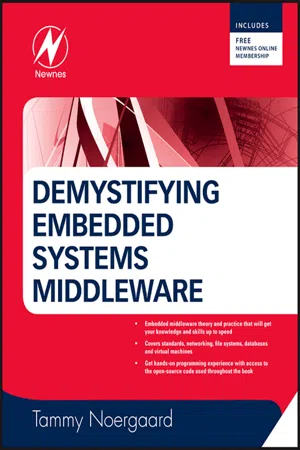
Demystifying Embedded Systems Middleware
Understanding File Systems, Databases, Virtual Machines, Networking and More!
- 408 pages
- English
- ePUB (mobile friendly)
- Available on iOS & Android
Demystifying Embedded Systems Middleware
Understanding File Systems, Databases, Virtual Machines, Networking and More!
About This Book
This practical technical guide to embedded middleware implementation offers a coherent framework that guides readers through all the key concepts necessary to gain an understanding of this broad topic. Big picture theoretical discussion is integrated with down-to-earth advice on successful real-world use via step-by-step examples of each type of middleware implementation. Technically detailed case studies bring it all together, by providing insight into typical engineering situations readers are likely to encounter. Expert author Tammy Noergaard keeps explanations as simple and readable as possible, eschewing jargon and carefully defining acronyms.
The start of each chapter includes a "setting the stage" section, so readers can take a step back and understand the context and applications of the information being provided. Core middleware, such as networking protocols, file systems, virtual machines, and databases; more complex middleware that builds upon generic pieces, such as MOM, ORB, and RPC; and integrated middleware software packages, such as embedded JVMs, .NET, and CORBA packages are all demystified.
- Embedded middleware theory and practice that will get your knowledge and skills up to speed
- Covers standards, networking, file systems, virtual machines, and more
- Get hands-on programming experience by starting with the downloadable open source code examples from book website
Frequently asked questions
Information
Demystifying Middleware in Embedded Systems
Publisher Summary
Chapter Points
1.1 What is the Middleware of an Embedded System?
| Requirement | Description |
| Adaptive | Middleware that enables overlying middleware and/or embedded applications to adapt to changing availability of system resources |
| Flexibility and Scalability | Middleware that allows overlying middleware and/or embedded applications to be configurable and customizable in terms of functionality that can be scaled in or out depending on application requirements, over all device requirements, and underlying system software and hardware limitations |
| Security | Middleware that insures the overlying middleware and/or embedded applications (and the users using them) have authorized access to resources |
| Portability | The ‘write-once’, ‘run-anywhere’ mantra. Middleware that allows overlying middleware and/or embedded applications to run on different types of embedded devices with different underlying system software and hardware layers. To avoid requiring time-consuming and expensive rewrites of the application code, middleware can mask the differences in underlying layers within different types of embedded systems, programming languages, and even implementations of the same standard produced by different design teams |
| Connectivity and Inter-Communication | Middleware that provides overlying middleware and/or embedded applications the ability to transparently communicate with other applications on a remote device through some user-friendly, standardized interface. Essentially, communication interfaces abstracted to level of local procedure call or method invocation |


Table of contents
- Cover image
- Title page
- Table of Contents
- Copyright
- About the Author
- Chapter 1. Demystifying Middleware in Embedded Systems
- Chapter 2. The Foundation
- Chapter 3. Middleware and Standards in Embedded Systems
- Chapter 4. The Fundamentals in Understanding Networking Middleware
- Chapter 5. File Systems
- Chapter 6. Virtual Machines in Middleware
- Chapter 7. An Introduction to the Fundamentals of Database Systems
- Chapter 8. Putting It All Together: Complex Messaging, Communication, and Security
- Chapter 9. The Holistic View to Demystifying Middleware
- Appendix A. Abbreviations and Acronyms
- Appendix B. Embedded Systems Glossary
- Index